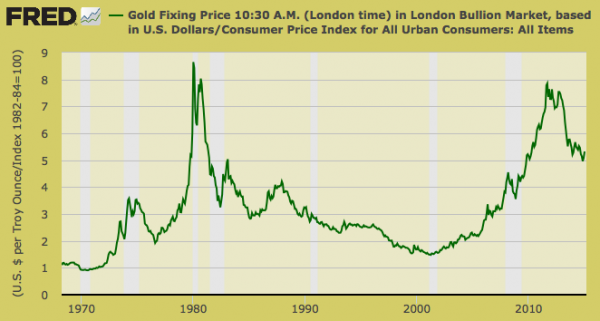
My argument isn’t to make the claim that the market cannot be beaten with analysis. I would never say that. It’s easy to find mutual fund managers who have beaten the market in the past. It’s much harder to determine if a particular manager was lucky or skillful at doing it.
Eugene F. Fama and Kenneth R. French looked into this issue in their working paper titled, Luck versus Skill in the Cross Section of Mutual Fund Returns. Their study focused on U.S. equity mutual fund managers from 1984 to 2006. It’s no surprise that they found that in aggregate, actively-managed U.S. equity mutual funds performed close to the market before costs and below the market after costs. The big question they were trying answer was did the winning managers have skill or were they just lucky?
From:http://www.forbes.com/sites/rickferri/2012/03/12/why-smart-people-fail-to-beat-the-market/
Part 2 in Analyzing Yachtman’s Long-term Performance
In part three, I will put forth my two cents on the skill vs. luck question. I do have issues with the way IFA.com presents their analysis/results. What do YOU think?
In part one, http://wp.me/p1PgpH-BG, Yachtman’s results were presented: On an Annual Basis: His three-year returns: 8.93%; five-year: 8.49%; ten-year: 13.59%. Those results won him Morningstar’s Manager of the Year for Large Cap Value.
Now, an analyst from www.ifa.com discusses Morningstar’s Manager of the Year, Mr. Yachtman’s long-term returns (since inception of the Yachtman Fund or 18 years). Does he generate Alpha? Would you be better off in an index fund? Watch the nine minute video http://www.youtube.com/watch?v=bU7qXfWciUw&feature=related
To see a chart of Yachtman’s, Miller’s and other famous gurus’ performance analyzed by IFA go to: http://www.ifa.com/12steps/step3/step3page2.asp#332 Click on CHART INDEX, then #3 Stock Pickers, then Scroll down and click on Yachtman Chart/Performance on the right. View analyses of other money managers.
More research on analyzing fund performance:
False Discoveries in Mutual Fund Performance, Measuring Luck in Estimating Alphas: http://ssrn.com/abstract=869748
ABSTRACT: This paper uses a new approach to determine the fraction of truly skilled managers among the universe of U.S. domestic-equity mutual funds over the 1975 to 2006 period. We develop a simple technique that properly accounts for “false discoveries,” or mutual funds which exhibit significant alphas by luck alone. We use this technique to precisely separate actively managed funds into those having (1) unskilled, (2) zero-alpha, and (3) skilled fund managers, net of expenses, even with cross-fund dependencies in estimated alphas. This separation into skill groups allows several new insights. First, we find that the majority of funds (75.4%) pick stocks well enough to cover their trading costs and other expenses, producing a zero alpha, consistent with the equilibrium model of Berk and Green (2004). Further, we find a significant proportion of skilled (positive alpha) funds prior to 1995, but almost none by 2006, accompanied by a large increase in unskilled (negative alpha) fund managers—due both to a large reduction in the proportion of fund managers with stock-picking skills and to a persistent level of expenses that exceed the value generated by these managers. Finally, we show that controlling for false discoveries substantially improves the ability to find funds with persistent performance.
The role of Return Based Style Analysis. Understanding, implementing and interpreting the technique. http://www.ifa.com/Media/Images/PDF%20files/styledriftibbotson.pdf
Introduction
Since its introduction in 1989, returns-based style analysis has fundamentally changed the way many investment analysts assess the behavior of money managers 1 .A number of firms quickly appreciated the benefits of this new technique and began selling software that would perform the necessary calculations. Today, style analysis is no longer housed only within the purview of highly paid consultants and mutual fund rating agencies, instead, anyone with a PC and a little data can assess the style of managers and mutual funds.
Of course, as with any sophisticated new technique, returns-based style analysis has been the source of considerable debate. Generally we have found that the debate relates to two main areas: 1) the role of returns-based style analysis and 2) proper implementation and application of the technique. The purpose of this paper is first to provide a quick summary of what returns-based style analysis is. We then will do some trouble-shooting, addressing potential pitfalls one by one, with an eye to providing insights and methodologies for effective implementation and interpretation of the analysis.
1 Returns-
What is Returns-Based Style Analysis?
Returns-based style analysis is a statistical technique that identifies what combination of long positions in passive indexes would have most closely replicated the actual performance of a fund over a specified time period. The passive indexes selected typically represent distinct investment styles within particular asset classes. For example, we might use returns-based style analysis across the large company stock, international stock, and small company stock indexes for an equity manager with a global mandate (“Global Fund”). Given a time period of, say January 1985 to December 1987, we may see results such as 50 percent international stock, 25 percent large company stock, and 25 percent small company stock.
Don’t be fooled!
There are many lessons. Note how important the time periods chosen are in illustrating results, but are the records statistically significant? Skill or luck? Are there any problems with the statistical method applied to the fund manager’s results? Are there any biases by the firm doing the report?
Mimics
At the end of the day, we want to learn from Mr. Yachtman’s value investing approach, but remain true to ourselves. Yo don’t want to blindly mimic anyone.
Jim Carey doing Vanilla Ice (twisted): http://www.youtube.com/watch?v=0A7tLVIsuNw
Michael Jackson Parady (Do NOT watch if you are a fan!): http://www.youtube.com/watch?v=F3H6hRNwgtc&feature=related
MC Hammer: http://www.youtube.com/watch?v=tYi3pwK6KkI&feature=related
Be successful in your own way.






